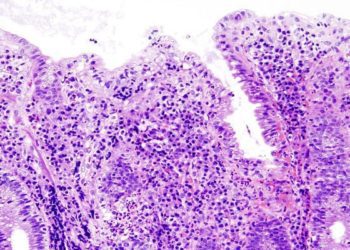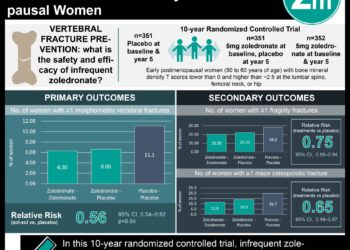Romosozumab significantly increases bone mineral density in postmenopausal women
Image: PD
1. Romosozumab, an anti-sclerostin antibody, significantly increased bone mineral density in postmenopausal women compared to placebo.
2. When given monthly at a dose of 210 mg, Romosozumab increased bone mineral density to a greater extent than either alendronate or teriparatide.
Evidence Rating Level: 1 (Excellent)
Study Rundown: Sclerostin is an osteocyte-secreted glycoprotein which impedes osteoblast proliferation and activity; treatment with romosozumab, an anti-sclerostin antibody, is therefore expected to enhance bone formation. In this phase 2 trial, romosozumab significantly improved bone mineral density (BMD) at the lumbar spine, total hip and femoral neck in postmenopausal women with low BMD. Importantly, when given at a dose of 210 mg monthly, romosozumab increased BMD to a greater extent than either alendronate or teriparatide.
These findings are exciting for several reasons. Existing therapies for osteoporosis include anabolic and antiresorptive agents. As an anabolic agent, romosozumab has the potential to restore bone structure; antiresorptive therapies, such as bisphosphonates, lack this ability. Teriparatide is an anabolic agent currently on the market. Treatment with teriparatide, however, requires daily injections and has been associated with osteosarcoma in animal studies. Interestingly, changes in bone turnover markers suggest that romosozumab transiently stimulates bone formation and chronically suppresses bone resorption; this combination may result in an especially effective therapy. Further studies with longer follow-up are needed to confirm the results of the trial. It will also be necessary to investigate whether observed increases in BMD translate to reductions in fracture risk.
Click to read the study, published today in NEJM
Click to read an accompanying editorial in NEJM
Relevant reading: Sclerostin is a delayed secreted product of osteocytes that inhibits bone formation
In-Depth [randomized controlled trial]: In this phase 2 multicenter trial, 419 postmenopausal women with low BMD were randomized to receive subcutaneous romosozumab (given monthly or every 3 months at varying doses), subcutaneous placebo or an open-label comparator (weekly oral alendronate or daily subcutaneous teriparatide). The primary end point was change from baseline BMD at the lumbar spine at month 12. Other end points included change from baseline BMD at the total hip and femoral neck. Additionally, bone-formation and bone-resorption markers were measured at baseline and at 1, 3, 6, 9 and 12 months.
The pooled romosozumab group had a significant increase in lumbar spine BMD compared to the pooled placebo group at month 12 (p<0.001); this was true regardless of romosozumab dose or dosing schedule. Significant increases in total hip and femoral neck BMD with romosozumab compared to placebo were also observed (p<0.001 for all comparisons). At month 12, the highest dose of romosozumab (210 mg monthly) resulted in mean BMD increases of 11.4%, 4.1% and 3.7% at the lumbar spine, total hip and femoral neck, respectively; these increases were significantly greater than those observed in either the alendronate or teriparatide groups (p<0.001). Romosozumab resulted in transient increases in bone-formation markers; levels returned to baseline between months 2 and 9. The levels of bone-resorption markers remained suppressed at month 12 in those receiving monthly romosozumab. Adverse effects were similar in the romosozumab and placebo groups.
By Hayley Walker and Xu Gao
More from this author: Solanezumab does not improve cognition or functioning in Alzheimer’s disease [EXPEDITION trials], Low brown fat may explain increased susceptibility to type 2 diabetes in south Asians, Dual PDE3/PDE4 inhibitor may be effective treatment for asthma and COPD, Alefacept may be effective therapy in newly diagnosed type 1 diabetics, Remote ischemic preconditioning reduced myocardial injury in CABG patients
©2012-2014 2minutemedicine.com. All rights reserved. No works may be reproduced without expressed written consent from 2minutemedicine.com. Disclaimer: We present factual information directly from peer reviewed medical journals. No post should be construed as medical advice and is not intended as such by the authors, editors, staff or by 2minutemedicine.com. PLEASE SEE A HEALTHCARE PROVIDER IN YOUR AREA IF YOU SEEK MEDICAL ADVICE OF ANY SORT.




